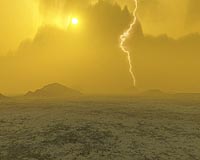 |
Tucson AZ (SPX) Sep 17, 2009 Scientists from the Tucson-based Planetary Science Institute have created the first detailed maps that show the amount of dry ice (solid carbon dioxide) deposited in the polar regions of Mars. The maps reveal how the ice thickness varies with the seasons. The maps were created from measurements taken by the Mars Odyssey neutron spectrometer, said PSI Senior Scientist Thomas H. Prettyman, who is the principal author of a paper on this work that was recently published in the Journal of Geophysical Research, "Characterization of Mars' Seasonal Caps Using Neutron Spectroscopy." The spectroscopy data, gathered during two Martian years, allowed Prettyman and his colleagues to accurately determine the thickness of the Martian ice caps over time. The amount of carbon dioxide ice at the poles varies in response to seasonal changes in sunlight, and about 25 percent of the atmosphere is cycled through the seasonal caps, Prettyman explained. "We need a detailed understanding of the present atmosphere on Mars in order to answer fundamental questions about the planet's climate history, including whether conditions on Mars could have been suitable for life in the distant past," he explained. The local thickness of the polar caps depends on several factors, such as the amount of solar energy absorbed by the surface and atmosphere and the flow of warm air from lower latitudes that accompanies carbon dioxide condensation at the poles, Prettyman said. In the northern polar region, carbon dioxide deposition is skewed toward an area known as "Acidalia," Prettyman observed. Thicker carbon dioxide ice in that region may be caused by frigid winds coming from Chasma Boreale, a large canyon near the Martian north pole. In the southern hemisphere, carbon dioxide ice accumulates more rapidly in a region known as the south polar residual cap, which is offset from the pole and contains perennial carbon dioxide ice deposits. Prettyman and his colleagues concluded that the asymmetry in the south polar seasonal cap is caused primarily by variations in surface composition. "The regions outside the residual cap consist of water ice mixed with rocks and soil that are warmed during summer," he said. "This delays the onset of carbon dioxide ice accumulation in the fall. In addition, heat stored in water-rich regions is gradually released during fall and winter, further limiting ice accumulation." Prettyman and his colleagues also used neutron spectroscopy to determine how much non-condensable gas (argon and nitrogen) remains in the atmosphere at high latitudes as carbon dioxide condenses. "We observed strong enrichment of non-condensable gas at the south pole during fall and winter," Prettyman said. "The observed time variation of the concentration of nitrogen and argon provides information about local circulation patterns. This includes the timing and strength of the polar winter vortex, a large-scale, cyclonic flow that inhibits mixing of nitrogen and argon with air from lower latitudes." Accurate data on the thickness of carbon dioxide ice and its distribution, as well as data on seasonal concentrations of non-condensable gases, will allow scientists to refine Martian general circulation models, Prettyman said. This will give them a deeper understanding of atmospheric dynamics and the planet's climate change over time. Neutron spectroscopy is key to determining carbon dioxide ice thickness during the long polar nights, Prettyman explained. "Unlike optical techniques, neutron spectroscopy does not require sunlight and can peer into the darkness, revealing details of the seasonal caps that have never been observed before," he said. Prettyman, PSI Senior Scientist William Feldman, and Timothy Titus of the U.S. Geological Survey in Flagstaff, Ariz., conducted the research with funding provided by the NASA Mars Odyssey Participating Scientist Program. The neutron spectrometer is a subsystem of the gamma ray spectrometer instrument suite on Mars Odyssey. Share This Article With Planet Earth
Related Links the missing link Mars News and Information at MarsDaily.com Lunar Dreams and more
 Evidence Found Of Lightning On Mars
Evidence Found Of Lightning On MarsAnn Arbor MI (SPX) Jun 18, 2009 U.S. scientists say they have detected the first direct evidence of lightning occurring on Mars. University of Michigan researchers said they found signs of electrical discharges during dust storms on the red planet. The bolts were dry lightning, Professor Chris Ruf said. "What we saw on Mars was a series of huge and sudden electrical discharges caused by a large dust storm," Ruf said. ... read more |
|
| The content herein, unless otherwise known to be public domain, are Copyright 1995-2009 - SpaceDaily. AFP and UPI Wire Stories are copyright Agence France-Presse and United Press International. ESA Portal Reports are copyright European Space Agency. All NASA sourced material is public domain. Additional copyrights may apply in whole or part to other bona fide parties. Advertising does not imply endorsement,agreement or approval of any opinions, statements or information provided by SpaceDaily on any Web page published or hosted by SpaceDaily. Privacy Statement |